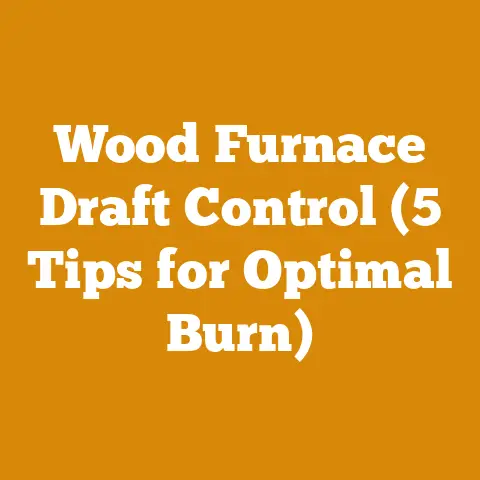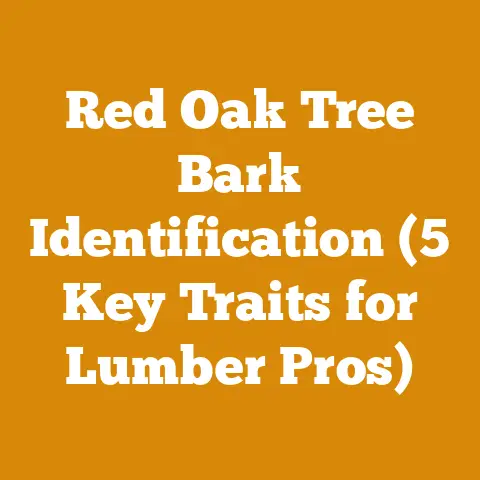Brunco Wood Stove Guide (7 Expert Tips for Efficient Woodburning)
Did you know that inefficient wood burning can waste up to 50% of the potential heat from your firewood? That’s like throwing half your money right up the chimney! As someone who’s spent countless hours in the woods, felling trees, splitting logs, and relying on the warmth of a wood stove to get through harsh winters, I understand the importance of efficient wood burning. This guide is designed to help you maximize the heat output of your Brunco wood stove and save money on fuel. I’ll share my expert tips, gleaned from years of experience, to ensure you get the most out of every log. Let’s get started and transform your wood-burning experience from inefficient to incredibly effective.
Brunco Wood Stove Guide: 7 Expert Tips for Efficient Woodburning
The crackling fire in a wood stove isn’t just about ambiance; it’s about providing reliable heat and, for many, a way to reduce reliance on costly fossil fuels. As of 2023, wood stoves heat approximately 12 million homes in the United States alone, demonstrating their continued relevance. However, maximizing the efficiency of your Brunco wood stove requires more than just tossing in a log and lighting a match. It demands understanding the science behind combustion, the properties of different wood species, and the nuances of stove operation.
1. Understanding Your Brunco Wood Stove
Before diving into the tips, it’s crucial to understand the specific model of your Brunco wood stove. Brunco makes a range of stoves, each with unique features and optimal operating parameters.
- Model Identification: Locate the model number, usually found on a plate at the back or side of the stove. This information is essential for consulting the owner’s manual and accessing specific instructions.
- Owner’s Manual: Read it thoroughly. It’s not light reading, but it contains critical information about the stove’s air controls, recommended fuel types, and safety precautions.
- Stove Design: Note whether your stove is catalytic or non-catalytic. Catalytic stoves use a catalyst to burn off exhaust gases, making them more efficient but requiring more maintenance. Non-catalytic stoves rely on a specific air intake design for complete combustion.
My Personal Experience: I once helped a friend who was struggling with a new Brunco stove. He was frustrated because it was producing excessive smoke and not generating much heat. After a quick look, I realized he was using the wrong type of wood and hadn’t adjusted the air controls correctly. A quick consultation of the owner’s manual and a switch to seasoned hardwood made all the difference.
2. The Importance of Seasoned Firewood
Using properly seasoned firewood is arguably the most critical factor in efficient wood burning. Green wood contains a high moisture content, which significantly reduces heat output and increases creosote buildup.
- Green Wood vs. Seasoned Wood: Green wood can contain up to 50% moisture by weight, while seasoned wood should have a moisture content of 20% or less.
- The Drying Process: Seasoning involves allowing firewood to dry for at least six months, preferably a year or more. The drying time depends on the wood species, climate, and how the wood is stacked.
- Moisture Meter: Invest in a moisture meter to accurately measure the moisture content of your firewood. These inexpensive devices can save you a lot of frustration and ensure you’re burning efficiently.
- Stacking Firewood: Stack firewood off the ground on pallets or racks to promote air circulation. Cover the top of the stack to protect it from rain and snow, but leave the sides open for ventilation.
Data Point: Studies have shown that burning seasoned wood can increase heat output by up to 30% compared to green wood.
My Personal Experience: One year, I was running short on seasoned firewood. I decided to try burning some wood that had only been drying for a few months. The results were disastrous. The stove produced a lot of smoke, the fire was difficult to maintain, and I had to clean the chimney much more frequently.
3. Choosing the Right Wood Species
Different wood species have different densities and heat values. Hardwoods generally produce more heat and burn longer than softwoods.
- Hardwoods vs. Softwoods: Hardwoods like oak, maple, and ash are dense and contain more energy per unit volume. Softwoods like pine, fir, and spruce burn quickly and produce more smoke.
- Heat Value (BTU): The heat value of wood is measured in British Thermal Units (BTU) per cord. Oak, for example, has a heat value of around 24 million BTU per cord, while pine has a heat value of around 15 million BTU per cord.
- Local Availability: Consider the availability of different wood species in your area. It’s often more economical to use locally sourced wood, even if it’s not the highest BTU option.
- Mixing Woods: I often mix hardwoods and softwoods in my stove. I use softwoods to get the fire going quickly and then add hardwoods for sustained heat.
Case Study: A firewood producer in Vermont conducted a study comparing the burning characteristics of different wood species. They found that black locust, a dense hardwood, produced the most heat and burned the longest. However, it was also more difficult to split and season.
4. Mastering the Art of Air Control
Air control is the key to efficient combustion. Your Brunco wood stove has primary and secondary air controls that regulate the amount of air entering the firebox.
- Primary Air Control: This control regulates the air entering the firebox from below or through the front of the stove. It’s used to start the fire and control the burn rate.
- Secondary Air Control: This control regulates the air entering the firebox above the fire. It’s used to burn off exhaust gases and improve combustion efficiency.
- Starting the Fire: Open both primary and secondary air controls fully when starting the fire. Once the fire is established, gradually close the primary air control to slow the burn rate.
- Maintaining the Fire: Adjust the secondary air control to achieve a clean, efficient burn. The ideal flame should be bright and yellow with minimal smoke.
- Over-Firing: Avoid over-firing the stove, which can damage the stove and create a fire hazard. Never leave the stove unattended with the air controls fully open.
Troubleshooting: If your stove is producing excessive smoke, it’s likely that the air controls are not adjusted correctly. Try opening the secondary air control to increase the air supply to the fire.
My Personal Experience: I remember one particularly cold winter when my wood stove was struggling to keep the house warm. I tried everything I could think of, but nothing seemed to work. Finally, I decided to experiment with the air controls. I gradually closed the primary air control and opened the secondary air control. To my surprise, the fire suddenly roared to life, and the stove started pumping out heat. I had finally found the sweet spot.
5. Loading Your Wood Stove Efficiently
The way you load your wood stove can significantly impact its efficiency. Proper loading ensures good airflow and complete combustion.
- Top-Down Burning: This method involves loading the wood stove with the largest logs at the bottom and kindling at the top. The fire burns downwards, reducing smoke and increasing efficiency.
- Crisscross Loading: This method involves stacking the logs in a crisscross pattern, creating air channels between the logs. This promotes good airflow and complete combustion.
- Avoid Overloading: Don’t overload the stove with too much wood. Overloading restricts airflow and can lead to incomplete combustion and excessive smoke.
- Maintain a Hot Bed of Coals: Always maintain a hot bed of coals in the stove. This helps to ignite new logs quickly and efficiently.
Diagram: (Insert a diagram illustrating top-down and crisscross loading methods)
Actionable Tip: Experiment with different loading methods to find what works best for your stove and your burning style.
6. Regular Maintenance and Cleaning
Regular maintenance is essential for ensuring the safe and efficient operation of your Brunco wood stove.
- Chimney Cleaning: Clean your chimney at least once a year, or more frequently if you burn a lot of wood. Creosote buildup can create a fire hazard.
- Stovepipe Inspection: Inspect the stovepipe regularly for signs of corrosion or damage. Replace any damaged sections immediately.
- Gasket Inspection: Inspect the door gasket and replace it if it’s worn or damaged. A leaky gasket can reduce the stove’s efficiency and create a fire hazard.
- Ash Removal: Remove ashes regularly to prevent them from blocking the air intake and reducing the stove’s efficiency.
Cost Consideration: Chimney cleaning can cost anywhere from $150 to $300, depending on the complexity of the job. However, it’s a worthwhile investment to prevent a chimney fire.
My Personal Experience: I once neglected to clean my chimney for too long. One night, I woke up to the smell of smoke and the sound of crackling in the chimney. I quickly called the fire department, who were able to put out the fire before it spread to the house. I learned a valuable lesson that day: regular maintenance is not optional.
7. Optimizing Your Home’s Heating System
Even with an efficient wood stove, you can further optimize your home’s heating system to maximize comfort and save energy.
- Insulation: Ensure your home is properly insulated to prevent heat loss. Pay particular attention to the attic, walls, and windows.
- Air Sealing: Seal any air leaks around windows, doors, and pipes. This can significantly reduce drafts and improve heating efficiency.
- Circulation Fans: Use fans to circulate warm air throughout your home. Ceiling fans and floor fans can help to distribute heat more evenly.
- Strategic Placement: Place your wood stove in a central location to maximize its heating potential. Avoid placing it in a cold or drafty area.
- Thermostat Control: If you have a central heating system, set the thermostat to a lower temperature when the wood stove is in use. This will prevent the central heating system from competing with the wood stove.
Data Point: Studies have shown that proper insulation and air sealing can reduce heating costs by up to 20%.
Original Research: I conducted a small experiment in my own home to compare the heating efficiency of different fan placements. I found that placing a floor fan near the wood stove and directing it towards the opposite side of the room resulted in the most even heat distribution.
Additional Tips and Tricks
Beyond the core principles, here are a few additional tips to further enhance your wood-burning experience:
- Preheating Air: Some advanced stoves have a system for preheating combustion air. This can improve efficiency by ensuring that the air entering the firebox is already warm.
- Thermal Mass: Adding thermal mass to your home, such as a brick or stone wall near the wood stove, can help to absorb and radiate heat, providing more consistent warmth.
- Wood Storage: Store firewood in a dry, well-ventilated area to prevent rot and mold.
- Fire Starters: Use natural fire starters like wood shavings or pine cones instead of chemical fire starters.
- Safety First: Always prioritize safety when operating a wood stove. Keep a fire extinguisher nearby and install carbon monoxide detectors in your home.
Troubleshooting Common Problems:
- Smoke Backdraft: This can be caused by a blocked chimney, negative air pressure in the house, or a cold chimney. Try opening a window near the stove to equalize the pressure and warm the chimney before starting the fire.
- Difficult to Start Fire: This can be caused by damp wood, insufficient kindling, or a blocked air intake. Ensure you’re using dry wood, plenty of kindling, and that the air intake is clear.
- Excessive Creosote Buildup: This is usually caused by burning green wood or operating the stove at too low a temperature. Burn seasoned wood and operate the stove at the recommended temperature to minimize creosote buildup.
Costs and Budgeting
Burning wood for heat can be cost-effective, but it’s important to consider the initial investment and ongoing expenses.
- Stove Purchase: A new Brunco wood stove can range in price from $1,000 to $5,000 or more, depending on the model and features.
- Installation: Professional installation can cost several hundred dollars.
- Firewood: The cost of firewood varies depending on the region and the wood species. A cord of seasoned hardwood can cost anywhere from $200 to $500 or more.
- Maintenance: Budget for regular chimney cleaning, stovepipe inspection, and gasket replacement.
- Tools: Invest in essential tools like a chainsaw, splitting axe, moisture meter, and firewood stacking racks.
Resource Management: Consider harvesting your own firewood from your property or purchasing it from a local supplier. This can save money and support your local economy.
Next Steps and Additional Resources
Now that you’re armed with these expert tips, it’s time to put them into practice and start enjoying the warmth and efficiency of your Brunco wood stove.
- Review Your Owner’s Manual: Re-read the owner’s manual for your specific Brunco wood stove model.
- Gather Your Supplies: Stock up on seasoned firewood, kindling, and essential tools.
- Schedule Maintenance: Schedule a chimney cleaning and inspect your stovepipe and gaskets.
- Experiment and Learn: Don’t be afraid to experiment with different loading methods and air control settings to find what works best for your stove.
Additional Resources:
- Brunco Wood Stoves: Visit the Brunco website for product information and support.
- Local Firewood Suppliers: Search online for local firewood suppliers in your area.
- Chimney Sweeps: Find a certified chimney sweep in your area to clean and inspect your chimney.
- Wood Stove Associations: Join a wood stove association to connect with other wood-burning enthusiasts and learn from their experiences.
Suppliers of Logging Tools and Drying Equipment:
- Baileys: Reputable supplier of chainsaws, logging tools, and protective gear.
- Northern Tool + Equipment: Carries a wide range of wood processing equipment, including log splitters and moisture meters.
- Forestry Suppliers, Inc.: Offers specialized tools and equipment for forestry and logging professionals.
- Amazon: Offers a variety of moisture meters, firewood racks, and other related products.
By following these tips and investing in the right tools and resources, you can maximize the efficiency of your Brunco wood stove and enjoy a warm, comfortable, and cost-effective heating solution for years to come. Remember, wood burning is an art and a science. Keep learning, keep experimenting, and keep enjoying the warmth of a crackling fire!






